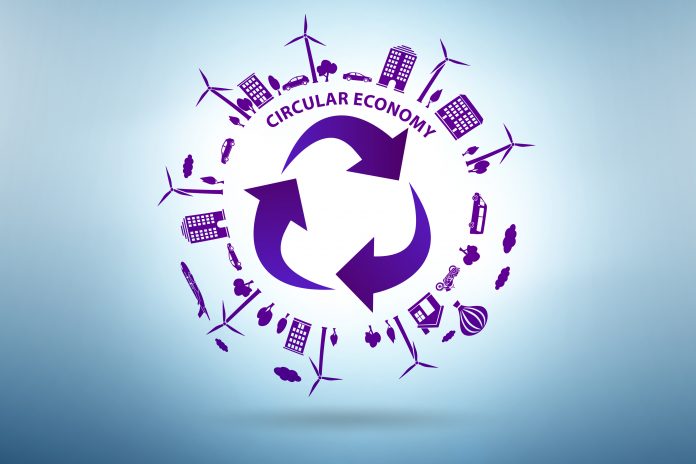Miranda Schnitger, Government Lead at the Ellen MacArthur Foundation, discusses the importance of the Universal circular economy policy goals to deliver the circular economy, particularly as we enter the year of COP26
Earlier this year, the Ellen MacArthur Foundation, which develops and promotes a circular economy transformation, launched a new set of Universal circular economy policy goals.
The circular economy offers a systems solution framework for creating economic value and growth, whilst at the same time addressing root causes of imminent global challenges such as climate change, biodiversity loss, waste and pollution. As governments focus on the COVID-19 recovery, there is a real opportunity to channel expertise and funds to the transition to an inclusive circular economy model. This will deliver both economic development and the tools to tackle global challenges.
The upcoming UNFCCC COP26 conference in November, hosted by the UK, provides an opportunity to focus international efforts on addressing and finding solutions to the next biggest challenge facing societies and the planet: climate change. As the pandemic has laid bare – there is a deep interplay between the economy, human health, and the environment. The transition to a circular economy model is now more pressing than ever, where these needs work together and not against one another.
The Universal circular economy policy goals offer a framework from which to build a shared policy and business understanding of how the three circular economy principles to: eliminate waste and pollution, keep products and materials in use and at value, and regenerate natural systems, can translate into five policy focus areas. With this shared understanding, a common direction of travel around the development of policies that will scale the transition can emerge. Being based on the three principles, the goals are universal. They were also designed in consultation with a wide number of public and private actors from across sectors and can offer a guide as to what to consider in the development of country and sector-specific policies for scaling a circular economy transition.
What are the goals?
The five goals cover: stimulating the transition to upstream circular design and business model choices; creating resource management systems that preserve value; making the broader economic conditions work; investing in innovation, infrastructure and skills; and collaborating for systems change by bringing stakeholders together and developing metrics and targets. Each one of these can be delivered through a range of policy measures.
To dive in a bit deeper:
The first goal, focused on stimulating design for the circular economy, explores how policy can incentivise the switch to circular design practices and circular business models across sectors and at scale. Example policies include developing product policies that support design for durability, repair, remanufacture, and refurbishment of durable goods, aligning construction and planning policies for the built environment with circular economy principles, encouraging regenerative production through agriculture, land-use and food policies, and ensuring chemical legislation, as well as restrictions and bans of certain substances, support circular outcomes.
The second goal works hand in hand with the first goal. It focuses on creating the systems for resource management that keeps products and materials in productive use and with preserved value. Example policies include the use of Extended Producer Responsibility and Deposit Return Schemes to help finance the collection, sorting, and recycling of goods and materials, developing harmonised collection and sorting policies for organic and non-organic materials and products, developing secondary material and by-product markets, using spatial planning policies to support materials flows and creating business opportunities such as industrial symbiosis, and disincentivising landfill and incineration.
The third goal focuses on creating the right economic conditions to make the circular economy work at scale. Example economic policies including tax incentives for circular practices such as including more recycled content in products or incentivising repair and maintenance, reforming and deploying subsidies and attaching conditions to government funds – some examples of which have been seen in the pandemic recovery response. It can also include ensuring that key policies are aligned with the circular economy, such as trade policies and disclosure requirements; and ensuring new policies, such as digital and data regulation, are cognisant of circular economy opportunities.
The fourth goal focuses on using public finance capabilities to invest and mobilise private investment in circular economy innovations, infrastructure, and skills. Example initiatives can include the funding of circular economy apprenticeships and training programmes. Circular economy initiatives are often synonymous with innovation, where cutting edge technology is used to create a product from a new biomaterial or recycled content. Early-stage public funding and blended finance solutions can catalyse innovation, with the latter also supporting enabling infrastructures. International aid funding can also help build capacity for circular economy trade in goods and services and local opportunities.
The fifth and final goal focuses on the ‘how’ of policymaking for system change. The transition requires innovation in engagement, and the involvement of actors from across the public, private, and civic sectors. To take a systemic lens to opportunities, public-private collaboration across value chains can play a key role in identifying unintended policy barriers as well as opportunities to create the enabling environment. Multi-stakeholder industrial alliances, as well as intergovernmental forums of exchange on best practice can be key. Inclusive circular economy roadmap development processes at local and national tiers can create a shared vision and commitment. Collaboration to set targets and develop the data needed to track the transition and incentivise action is also vital.
Why now?
We decided to launch the Universal circular economy policy goals to build on the momentum developing in the public and private sector over the past few years, as circular economy practices become better known and widespread. As more and more organisations engage with the circular economy, the role that policy can play in creating scale has come into greater focus. To support this, and ensure that the policy developments pull in the same direction to maximise the impact and enable scaled solutions, it was clear that we needed a common language and direction of travel. Without it, there is the risk that individual policy initiatives and voluntary commitments are stranded in a wider linear landscape, and therefore less effective, or pull in different directions. Singular commitments will not achieve a transition on the scale needed. For example, signatories of our New Plastics Economy Global Commitment represent 20% of the global market. A stronger, more internationally aligned policy environment could help propel these efforts to full scale. The Universal policy goals, therefore, bring that common language and support policy development and alignment for the transition to a society-wide circular economy.
How we developed the goals
The circular economy policy goals were developed with a global outlook. We consulted with policymakers and international institutions, including the World Bank, UNEP, and UNIDO, as well as with the private sector. We worked with several businesses from across different sectors – for example, Arup, IKEA, Solvay, and Unilever, amongst others. Input from both the public and private sector is vital as no one actor can achieve the transition alone. Both governments and businesses have a clear leadership role to play. That is why we call on businesses and policymakers at all levels to align behind these goals in their development of economy-wide roadmaps, and business and policy innovations and developments.
Using the goals to facilitate a global transition to the circular economy
We fully appreciate that different actors and countries will have different priorities, different starting points, and different needs, and facilitating wide-scale change in the face of global challenges like climate change and pollution is complicated. This is why the Universal circular economy policy goals are not prescriptive. Each goal is supported by a list of example policy measures, and countries can determine where they should focus first. As we navigate the second year of the COVID-19 pandemic and look ahead to creating an economic recovery that is resilient and can simultaneously help to address global challenges such as climate change and biodiversity loss, these Universal circular economy policy goals provide a framework for all to work with. They highlight the different areas of policy that need to be aligned if we are to create the circular economy transition that is needed and is consistent with the SDGs.











